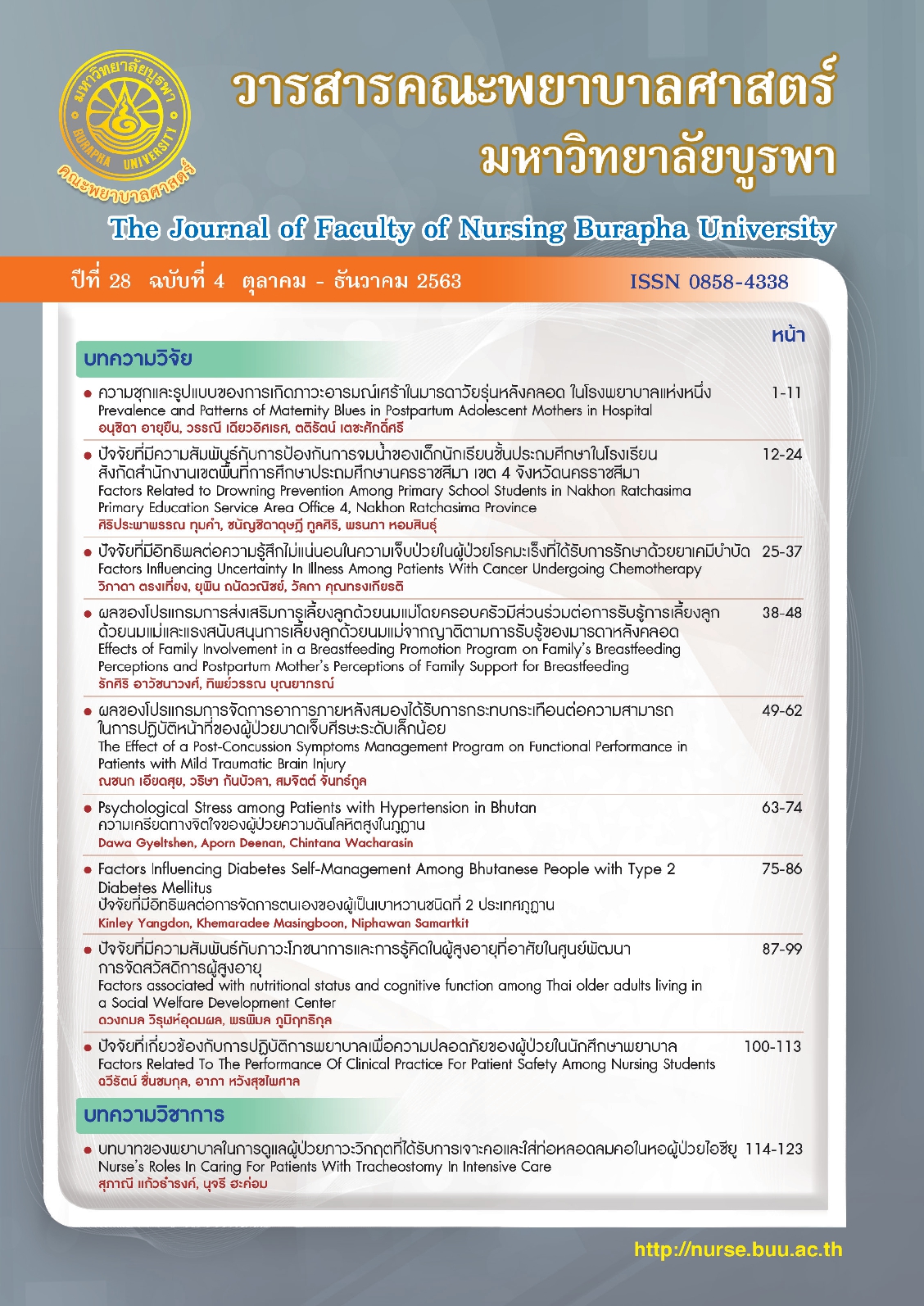ความชุกและรูปแบบของการเกิดภาวะอารมณ์เศร้าในมารดาวัยรุ่นหลังคลอด ในโรงพยาบาลแห่งหนึ่ง
คำสำคัญ:
อารมณ์เศร้าหลังคลอด, มารดาวัยรุ่น, ความชุกบทคัดย่อ
การวิจัยเชิงสำรวจนี้มีวัตถุประสงค์เพื่อศึกษาความชุกและรูปแบบของภาวะอารมณ์เศร้าหลังคลอดในมารดาวัยรุ่นหลังคลอด ในช่วง 7 วันหลังคลอด กลุ่มตัวอย่างคือ มารดาวัยรุ่นหลังคลอดที่มีอายุตั้งแต่ 10 - 19 ปี พักฟื้นที่แผนกหลังคลอด โรงพยาบาลสตึก จังหวัดบุรีรัมย์ จำนวน 115 ราย เก็บรวบรวมข้อมูลโดยให้มารดาตอบแบบสอบถามภาวะอารมณ์เศร้าหลังคลอด มีค่าความเชื่อมั่นเท่ากับ .81 วิเคราะห์ข้อมูลโดยใช้สถิติพรรณนาและการวิเคราะห์ความแปรปรวนทางเดียวแบบวัดซ้ำ
ผลการศึกษาพบว่า ในช่วง 7 วันหลังคลอด มารดามีภาวะอารมณ์เศร้าหลังคลอด คิดเป็นอัตราความชุกเท่ากับร้อยละ 49.60 ช่วงเวลาที่พบอารมณ์เศร้ามากที่สุดคือในวันที่ 3, 4 และ 5 และจะค่อย ๆ ลดลงในวันที่ 6 และ 7 ตามลำดับ กลุ่มอาการแสดงที่พบมากที่สุด คือ กลุ่มอาการอารมณ์เศร้า พบร้อยละ 21.40 มารดาที่มีภาวะอารมณ์เศร้าหลังคลอดในระดับรุนแรง พบเพียงร้อยละ 3.48 และผลการวิเคราะห์คะแนนความรุนแรงของภาวะอารมณ์เศร้า ในช่วง 7 วันพบว่ามีความแตกต่างกันอย่างมีนัยสำคัญทางสถิติ (p < .05) ผลการศึกษานี้สามารถนำไปใช้ในการดูแลมารดาหลังคลอดวัยรุ่นโดยติดตามคัดกรองภาวะอารมณ์เศร้าหลังคลอดของมารดาวัยรุ่นเพื่อป้องกันความรุนแรงที่อาจพัฒนาต่อไปเป็นภาวะซึมเศร้าหลังคลอด
เอกสารอ้างอิง
Hongsrisawan N. (2016). Depression. Journal of Hua Chiew Chalermprakiet University, 19(38), 105-118. [In Thai]
Kennerley, H., & Gath, D. (1989). Maternity blues: I. Detection and measurement by questionnaire. British Journal of Psychiatry, 155(3), 356-362.
Letourneau, N., Stewart, M., Dennis, C. L., Hegadoren, K., Duffett‐Leger, L., & Watson, B. (2011). Effect of home‐based peer support on maternal-infant interactions among women with postpartum depression: A randomized, controlled trial. International Journal of Mental Health Nursing, 20(5), 345-357.
Manjunath, N. G., Venkatesh, G., & Rajanna (2011). Postpartum blue is common in socially and economically insecure mothers. Indian Journal of Community Medicine, 36(3), 231–233.
Moslemi, L., Tabari, M. G., Montazeri, S., & Tadayon, M. (2012). The frequency and several effective factors on baby blues. Journal of Society for Development in New Net Environment in B&H, 6(12), 4004-4008.
Nourollahpour Shiadeh, M., Kariman, N., Bakhtiari, M., Mansouri, S., & Mehravar, S. (2016). Unwanted pregnancy and its risk factors among pregnant women in Tehran, Iran. Nursing and midwifery studies, 5(3), 1-7.
O’Hara, M. W., & McCabe, J. E. (2013). Postpartum depression: Current status and future directions. Annual Review of Clinical Psychology, 2013(9), 379-407.
O'Hara, M. W., Schlechte, J. A., Lewis, D. A., & Wright, E. J. (1991). Prospective study of postpartum blues: Biologic and psychosocial factors. Archives of General Psychiatry, 48(9), 801-806.
Phuangprasonka, R., Deoisre, W., & Chunlestskul, K. (2016). Maternity blues and management strategies of Thai postpartum women. Journal of Food Health and Bioenvironmental Science, 11(2), 23-27
Piyanan M. (2000). Obstetrics (1st ed.). Bangkok: Ruen Kaew Printing. (in Thai)
Pop, V. J. M., Truijens, S. E. M., Spek, V., Wijnen, H. A., Van Son, M. J. M., & Bergink, V. (2015). A new concept of maternity blues: Is there a subgroup of women with rapid cycling mood symptoms. Journal of Affective Disorders, 2015(177), 74-79.
Reck, C., Stehle, E., Reinig, K., & Mundt , C. (2009). Maternity blues as a predictor of DSM-IV depression and anxiety disorders in the first three months postpartum. Journal of Affective Disorders, 113(1-2), 77-87.
Regional Health Promotion Center. (2017). Regional Health Promotion Center 9 Nakhon Ratchasima. Nakhon Ratchasima: Center 9 Nakhon Ratchasima. [In Thai]
Reuangrakul S. (2007). Pregnancy, psychiatric disorders and treatment (1st ed.). Bangkok: Ruen Kaew Printing. [In Thai]
Rondón, M. B. (2003). Maternity blues: Cross-cultural variations and emotional
changes. Primary Care Update for OB/GYNs, 10(4), 167-171.
Thammasuwan C. (2012). The effect of a mother's care program in which the child is admitted to the Neonatal Intensive Care Unit on anxiety and the relationship between the mother and the newborn. Master of Nursing Thesis, Advanced Midwifery Program, Graduate School, Mahidol University. [In Thai]
Worasing T. (2016). Pregnancy outcomes between teenage pregnancy and adult pregnancy. Medical Journal of Sisaket Hospital, Surin Buri Ram, 31(2) 61-69.
[In Thai]
Youngdee K, & Roomruangwong C. (2016). Depression after childbirth among mothers with obstetric complications in King Chulalongkorn Memorial Hospital. Chulalongkorn Medical Journal, 60(5), 561-574. [In Thai]
Yuki T., & Katsutoshi T. (2014). Factors associated with early postpartum maternity blues and depression tendency among Japanese mothers with full - term healthy infants. Nagoya Journal of Medical Science, 76(1-2), 129-138.





